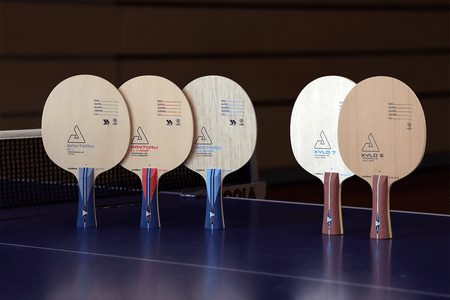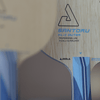
A Guide to Understanding Table Tennis Blades
Table tennis blades can be a subject of obsession for some, or of confusion for others. There are many different properties which affect how a table tennis blade can perform. Here we will help you understand the different factors that can affect your decisions, so that you can find the best blade to fit your game.
Before getting into the details of blade composition, here is an outline of the JOOLA Blade Lines guide:
PremiumJOOLA Premium Line blades are created using premium materials and with an absolute attention to craftsmanship. Our innovative composite materials are sourced from Japan. Handles, the most important connection to the blade, are imported from Italy. Final assembly is completed in South Korea with impeccable attention to detail. We employ high-tech manufacturing techniques such as computer-controlled routing, proprietary sanding methods, and unprecedented quality control. What you get when you use one of our JOOLA Premium Line blades will thoroughly impress you!
ProfessionalJOOLA Professional Line blades utilize innovative technologies, high-quality materials, and first-rate craftsmanship to create blades that will truly propel your game to the next level.
PerformanceJOOLA Performance Line blades are tried and true classics with proven playing characteristics that suit the needs of modern table tennis.
ProgressiveJOOLA Progressive Line blades are a great starting point for entry-level players who are ready to get serious about their game. These blades utilize straightforward technologies to create accessible playability.
PrecisionJOOLA Precision Line blades are specifically designed for modern defensive specialists. These high-quality blades utilize unique veneer combinations to craft an unparalleled defensive game.
Now we can look at some of the different properties you will need to consider when buying a table tennis blade.
Wood vs. Carbon
One of the challenging decisions facing players is whether to go for the classic all-wood blade, or to enter the faster realm of carbon fiber composite.

Benefits of All-Wood Blades: All-wood blades typically offer greater control and better feeling, allowing for easier variations and creative shots, but also more balance alongside faster racket builds. Being all-wood, however, doesn’t mean the blades are slow. There is a great range of different all-wood racket types, including more offensive models. Many of these high-quality all-wood rackets are found in JOOLA’s Performance and Professional Blade Lines.

Benefits of Carbon Fiber Blades: Carbon fiber blades offer a significant increase in speed and stiffness in the blade. These enhanced properties are perfect for offensive players who are looking for more power and precision in their game - above and beyond what all-wood blades are able to offer. There are also different types of carbon to consider, which we will get into later on. The more complex carbon fiber composites are prominent in the JOOLA Premium and Professional Blade Lines.
It would be advisable to have experience with all-wood blades and have worked on developing techniques before advancing to a carbon fiber blade. Not many players will buy a carbon fiber blade for their first custom racket.
5-Ply vs. 7-Ply
The majority of table tennis blades are either 5 plies or 7 plies. This of course refers to the number of layers that make up the blade. In general, the more plies a racket has, the faster it will be – although the weight of the blade may also have an effect.

5-Ply Blades: 5-ply blades are often associated with greater control and spin, featuring a thicker core layer, and one inner layer before the outer wood layer. The wood layers are thicker and often offer more flexibility and a lighter feeling. 5-ply blades are most often associated with the classic all-wood feel.

7-Ply Blades: 7-ply blades feature thinner layers of wood and of course more adhesive to combine the layers. This results in greater stiffness and less flexibility, allowing more power and precision. In general, 7-ply blades are often deemed to be faster on average than 5-ply.
While this gives some general insight into groups of blades on the whole, there are of course exceptions, and you will also need to consider the type of wood and/or fibers which make up the blade, as well as the weight.
Types of Wood

This is often an area which many players find confusing: The types of wood which blades are comprised of, and what properties they have – and how they affect performance. Here is a brief guide to the most common wood types.
KiriMost commonly used as a core layer wood, Kiri has a tight structure to control vibration in the racket. It is the most popular core layer for table tennis blades.
AyousLightweight and highly elastic, great for reactive play like close counters. Most well suited closer to the core layer, rather than the outer veneers.
A very common wood in blade manufacturing, noted as being softer than many of its counterparts, Limba offers exceptional control and stability and is especially common as an outer veneer to balance offensive blades.
HinokiRenowned for great touch and feeling, it can be slightly heavier and denser, allowing for good reactive offense. It is also a relatively soft wood allowing it to balance deftness and controlled skills like short touch and blocking.
KotoKoto wood is a sharp addition to offensive blades, best arranged as a thinner outer layer to a blade. Koto wood layers help add stiffness, precision and effective and powerful direct ball contact to a blade performance.
BalsaVery lightweight and low density, Balsa is perfect for blade cores and soft inner layers. Typically, those who like very light blades will opt for some kind of Balsa composition. Offers great dwell and is great for defenders or control spinners.
EXAMPLE
Playing Style: Close-table controlled attacker, focused on touch play and blocking/countering variations and using spin to pressure the opponent.
Racket to Consider: A 5-ply racket (not too fast, greater control feel and a spin focus), a Kiri core (most popular, reduced vibration) and then perhaps Ayous on the inner layer (great elasticity for close countering, better suited on inner layer), then for the outer layer Hinoki (great for touch and feeling, especially where variations of spin and speed are concerned).
A blade which meets these properties is the JOOLA Xylo 5 blade from the Professional Line, which could be a good blade to recommend or try as a player who meets this scenario style.
Types of Carbon Composite Fibers







Carbon Composite Fibers are the next step up for offensive players. These blades are most often found in JOOLA’s Professional and Premium Line blades, which are crafted for the highest levels of performance in table tennis.
PBO-cZylon Carbon Fiber is a more rigid carbon, but has significant elasticity. This creates exceptional speed and direct contact quality while also improving the overall feeling of the blade.
Super PBO-cA more densely woven Zylon Carbon Fiber, it creates even greater strength and power. This is used for some of the fastest table tennis blades available.
ARY-cThis one of the most popular composites in the world of table tennis, is slightly softer and more flexible, allowing for greater spin and control while still delivering additional power to the racket. It’s best suited at close or mid-range.
KL-c
Kevlar Carbon Fiber is slightly softer than ALC, offers great touch and precision and helps reduce vibration in the blade.
X3The X3 is a composite directional weave of ALC and PBO-c, with ALC vertical threads and PBO-c horizontal threads. This combines the best of both worlds – the stiffness and feeling of PBO-c, stabilized by the flexibility and control of ALC.
Types of Handles
There are two main types of handle shape common throughout the table tennis world - Straight and Flared handles. There are of course also Penhold blades, and the less common Anatomic handle. There are some things to consider when choosing even something as simple as the handle shape.
- Shakehand Blades: Longer in the handle, for shakehand players.
- Penhold Blades: Shorter in the handle, for penhold players.

With each of these standard blades, there are then ST, FL and AN handle types.
- Straight: The handle contour is straight, which makes it easier to transition between different shot types i.e forehand, backhand, short game for players who make minor grip adjustments for each.
- Flared: The flared blade contours out wider towards the bottom of the handle. These blades commonly help with grip stability and are slightly thicker. It is more common for forehand dominant players as it helps control the grip during powerful forehand swings.
- Anatomic: The AN handle is designed for comfort and melds with the shape of the hand. It is a much less common handle type in the world of blades.
Choose Blade Composition Based on Desired Properties
Think about your personal playing style and what you want for your game. Use this guide as a reference for which materials and features best align with what you need.




